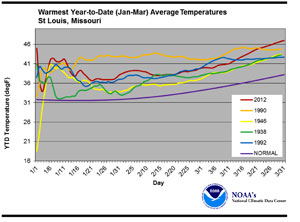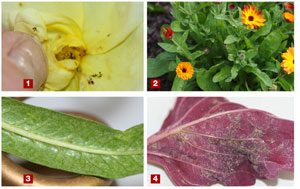5/21/2012
Are Thrips on the Rise in 2012?
Andy Seckinger

The weather of 2011 was one of extreme rain, drought, cold and heat, and 2012 has continued the abnormal trend.
For instance, in the St. Louis area, average temperatures from January 1 to March 31, 2012, were some of the warmest on record. January temperatures were 13 degrees above normal, while March 31 temperatures were 9 degrees above normal (see chart).
While the warm weather has provided a lift for both growers and retailers, it’s been a boon for insects as well. One of our most problematic insects are thrips, both Western Flower Thrips and the ever-increasing chili thrips.
As with most insects when the temperature increases, so do thrips populations. The life cycle becomes shorter and the potential for rapid population buildup increases.
At 60F (15C) (a normal March-April temperature), the thrips life cycle from egg to adults is 35 to 45 days. At 86F (30C), the life cycle shrinks to 12 to 15 days. In other words, a difference of 26 degrees cuts the life cycle development time by more than half.
The warm temperatures mean more blooms and early sales, but also more thrips with the early insect development. We’re also seeing fluctuations in temperatures with 4 to 5 days of warmth followed by 4 to 5 days of cooler and wetter conditions.
So what does this unusual weather mean to growers? According to Dr. Raymond Cloyd of Kansas State, it’s “because we are at least three weeks ahead of schedule in terms of plant development and many plants and weeds are in bloom, which provide a food source for thrips—including Western Flower Thrips.”
Dr. Cloyd went on to say, “These thrips can then migrate into greenhouses where they will be problematic. In addition, the high temperatures will decrease the time it takes for the life cycle (egg to adult) to be completed, which will likely result in multiple generations being present simultaneously. As such, growers need to implement pest management strategies accordingly.”
Fi gure 1 | Adult thrips on a rose.
gure 1 | Adult thrips on a rose.
Figure 2 | Thrips damage on a strawflower plant.
Figure 3 | Western Flower Thrips on an asclepias leaf.
Figure 4 | One of the more interesting photos taken in St. Louis in late April is the underside of a coleus leaf showing both downy mildew sporulation and thrips. We usually deal with these problems at separate times. This doubling up, compiled with heavy early shipping, is stressing all systems.
Behavior and symptoms
Thrips feed on plants by piercing plant tissue and sucking the resulting fluids. This feeding behavior results in abraded surfaces, which show as light scars on the upper surface of leaves and flowers (note the damage on the straw flower leaves on Figure 1). Because of this feeding behavior, thrips
can transmit diseases, such as tomato spotted wilt virus (TSWV) and other diseases merely by spreading the spores. If uncontrolled, thrips will render many plants unsellable either due to the feeding damage or the spread of disease.
Prevention and control
• Observe—If you don’t have a formal scout, make sure it’s someone’s job to inspect plants for problems on a routine basis … hopefully daily. Use sticky cards or other monitoring devices and change them on a regular basis.
• Identify—Make sure you can identify not only the problem, but also whether several life stages appear to be present. If necessary, send your sticky cards or insects to an entomologist in your area.
• Determine available solutions—the true IPM approach.
- Mechanical—Cards, screens, banker plants, controlling weeds outside the greenhouse.
- Insecticides
- Biological predators
- Build a program approach to last over the expected duration (4 weeks plus)
• Take action—Once you’ve decided on a course of action, move ahead. Remember during time of heavy pressure, you’ll probably need to decrease your control frequency.
• Measure success—Use sticky cards or other survey methods to determine if populations are building or decreasing. Observe the plants for not only thrips, but also possible damage or other issues. Decide which course of action gave you the best result in your operation.
• Record—Problems tend to repeat themselves; be ready for the next season. Also, plan to have your needed materials on hand to keep the problem under control.
Resources
Many states, as well as breeders and suppliers, offer free information to aid in not only identifying pests (thrips), but also give suggested program approaches. Kansas State University has a great extension publication available at
www.ksre.ksu.edu/library/entml2/mf2922.pdf.
OHP, Inc. also offers a program approach under their “Recipe for Success—Thrips Cocktail” publication:
www.ohp.com/Literature/pdf/Thrips_Cocktail.pdf.
The information age has provided us with a multitude of sources. A recent Google search on “Controlling Thrips on Ornamentals” resulted in 190,000 hits. Growers will face challenges with thrips and other pests, but with knowledge and planning they will continue to produce great crops despite these problems.
GT
Andy Seckinger is Marketing Manager for OHP, Inc. based in Mainland, Pennsylvania.